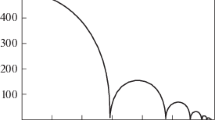Abstract
The effect of surface tension and viscosity forces on the rate of collapse of a cavitation vapor bubble has been quantitatively estimated. The results of corresponding computations of the cavity collapse rate obtained by exact and approximate methods are compared.
Similar content being viewed by others
References
A. D. Pernik, Cavitation Problems [in Russian], Sudpromgiz, 1963.
Rayleigh, Phil. Mag., 34, 1917,
S. S. Chu, Proc. of the First U. S. Nat. Congress Appl. Mech. ASME, 1952.
E. I. Zababakhin, PMM, vol. XXIV, no. 6,1960.
H. Poritsky, Proc. of the First U. S. Nat. Congress Appl. Mech. ASME, 1952.
Rights and permissions
About this article
Cite this article
Levkovskii, Y.L., Il'in, V.P. Effect of surface tension and viscosity on the collapse of a cavitation bubble. Journal of Engineering Physics 14, 478–480 (1968). https://doi.org/10.1007/BF00828072
Issue Date:
DOI: https://doi.org/10.1007/BF00828072




